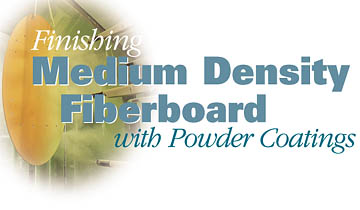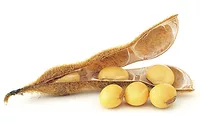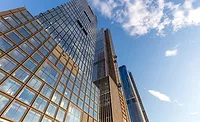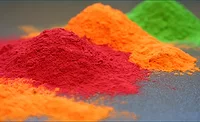Finishing Medium Density Fiberboard with Powder Coatings

Why Powder Coatings?
Powder coatings are the finish of choice in many segments of the metal finishing industry.1-3 Growth in powder usage is driven by many factors, including the following.- Environmental compliance - no VOCs or HAPs
- Performance - solid polymers offer inherent toughness
- Economic advantages - savings lead to fast capital payback
- High quality - easy to automate and control, low reject rate
- Wide appearance range - an abundance of color, texture gloss variations.
Manufacturing engineers, familiar with liquid painting and laminating, also understand the process benefits of a single step powder coat, which include the following.
- Reduced work in process - no intermediate sanding steps
- Reduced waste - no overspray (collected and reused), solvents or trim scrap
- Ease of handling - no dilution, mixing or glue to deal with
- Fast match/small batch capability - specialty colors delivered in a week
- High productivity - continuous process.
Despite all of these positives, powder coating on MDF is not perfect. To date it has not yet equaled the performance of the best high pressure laminate (HPL) (see Table 1). It also has some appearance limitations, i.e., wood grain looks are not available in one step. Finally, powder coatings are substrate sensitive in some respects. Important MDF characteristics include the following.
Powder coatings fit the needs of a variety of markets where MDF or other engineered wood products are used, including the following.
Kitchen and bath cabinetry where powder coated components meet Kitchen Cabinet Manufacturing Association requirements and offer added benefits of non-yellowing, no delaminating, and superior heat, light and moisture resistance (see Table 2).
Office furniture where powder coated horizontal and vertical surfaces meet applicable National Electrical Manufacturers Association and Business and Institutional Furniture Manufacturer's Association standards as well as tough original equipment manufacturer (OEM) specifications.
Ready-to-Assemble (RTA), Small Office/Home Office, and Institutional furniture, and store fixture/display and other markets where powder's high performance-to-price ratio represents value that can be passed on to the end user.

The Process
The performance of any finished component starts with the selection of a substrate that meets structural, mechanical, processing, maintenance and other needs. Substrate requirements are equally important for powder and liquid coating and laminating. It therefore pays dividends to select the right MDF for the job. This means that characteristics such as substrate sensitivity must be considered before the coating work begins.Once the MDF is selected, cut and machined it may require further sanding depending on the surface quality from the mill, the quality of the routing or other machining and, most importantly, the quality requirements of the finish. Most coatings will telegraph substrate defects such as nicks and scratches along with sanding marks, so coarse followed by fine sanding may be necessary. Automated wide belt and fladder sanders have been used successfully to prepare MDF for coating. Any extraneous dust must be removed to avoid contamination and resulting surface defects.
The preheat stage of the powder coating process accomplishes two important objectives. First, it preconditions the board by redistributing the moisture and allowing for degassing to take place. Second, it brings the board up to suitable temperature to soften or partially melt the powder, which helps the powder to stick to the substrate.
In some circumstances MDF may retain enough surface moisture to be electrostatically coatable without preheat; however, this requires tight control in board manufacturing, shipping and storage, and still does not address potential problems without gassing during subsequent heating. Conductive primers have also been tried with limited success.
Preheating can be accomplished with convection heat, infrared (IR) radiation or a combination of the two. The goal is to consistently provide the specified coating manufacturer board surface temperature (BST) at the spray guns. Generally this means that the preheat oven must be positioned close to the coating booth to avoid wasted energy from cooling parts (see Figure).
Powder application is accomplished by standard corona or tribo charging guns in a standard powder coating booth equipped with a recovery system. The electrostatic effects are easily seen, appearing as poor coverage if moisture or earth ground are removed. Automatic reciprocating gun movement and triggering have proven essential for film thickness control and appearance uniformity. The booth is typically housed in a positive pressure, environmentally controlled room to avoid contamination and to reduce the heat load from incoming boards.
The next step is flow out and cure. Here it must be understood that there are two cure options available and the equipment must be matched to the powder cure mechanism.
For thermal cure, heat in the form of convection or IR is used to melt and flow the powder with curing or crosslinking taking place simultaneously. These powders are specially formulated for application, wetting and cure on engineered wood products.
Cure with ultraviolet (UV) light is another option. In this case, the powder must still be heated to achieve melt and flow, after which exposure to UV light causes crosslinking to take place. The two primary types of UV equipment are microwave and arc lamps. In either case mercury, with or without a mixture of metal halides, in a sealed quartz tube is energized to produce a UV emission spectrum compatible with the photoinitiator used in the coating.8
Parts are transported through the process by suspension on an overhead conveyor or on a horizontal belt system. The former offers higher productivity with the potential for multiple rows of parts on a rack, while the latter may be a better fit with current processing orientation. Horizontal systems have not reached commercialization in the United States partially because of issues with full coverage on edges and wrap around to the back side if the part is lifted slightly off of the belt. Cooling to room temperature for inspection and packaging is accomplished with longer conveyor travel or a cooling tunnel to bring parts back to near room temperature.
Coating Selection
Whether thermal cure or UV, systems already in place for powder coating metal parts are generally not adaptable to coating MDF. Therefore, most people making the move to coat MDF face many decisions. In this regard, there is no substitute for testing - coating a candidate powder on actual parts with the equipment under consideration. This is particularly true in evaluating thermal vs. UV cure mechanisms where an understanding of limitations as well as benefits will drive any planned equipment purchase (see Table 3).Selection of the proper coating starts with defining the appearance desired, including color, gloss and texture. This is followed closely by defining performance requirements with the help of a specification, industry standard or by thorough consideration of end use requirements with the coating manufacturer. It is always helpful to break down "requirements" as wants or needs, or to prioritize them because coating formulation is often a process of balancing properties. This ranking process also helps to prevent over-engineered products, which come with some added cost.
When considering the best coating for the job, it's important to go beyond the distinction of thermal vs. UV cure mechanisms. That is to say that there are many coating sub-classification possibilities under each mechanism, based upon resin or cure chemistry for example, and these can have significant differences in performance (see Table 4).
Other factors to be considered in coating selection include the following.
It is an oversimplification to consider coatings based solely on price per pound since higher performance or ease of application usually come at a short-term cost that may turn in to long-term savings. Standard powders for metal may seem attractive economically, but they typically do not look or perform as well as powders specifically designed for MDF. Also, since processing steps are likely to be eliminated with powder, it is more appropriate to consider the total cost of the finished component rather that the stand alone cost of the finish. This analysis would include labor, energy, environmental compliance and other costs (see Tables 5-7).
The Finished Product
The first impression of a powder coated MDF surface is based on sight and touch. Color, gloss and texture are combined with shape and functionality to fulfill the designer's goals in a way that is not otherwise easy to achieve. Beyond the aesthetic, there are typically other goals to meet, however. Overall durability and performance qualities discussed earlier are often dependent on other factors. These start with complete coverage. Since raw MDF is hygroscopic it will take on moisture, equilibrating with the environment, up to approximately 12-15% by weight. Moisture uptake results in swelling which can produce dimensional changes exceeding 100%. Powder coatings provide a moisture barrier that significantly decreases this tendency; however, to do so effectively, all areas of the part must be encapsulated with the coating. Areas that can be the hardest to cover are sharp edges where the parts lose heat rapidly, not allowing the coating to stick or adhere sufficiently. Conversely, too much heat on sharp edges will dry them out leading again to poor electrostatic deposition and insufficient coverage.Closely related to complete coverage is film thickness. Here, it should be noted that typical film thickness gauges used for powder on metal do not work on MDF or other nonmetals. Ultrasonic gauges are useful for smooth, nonmetallic containing powders, but they lose accuracy with textures and metal containing powders because they detect any interface. Other methods are destructive and therefore do not find wide use for quality control.
Most coatings are designed to apply and perform at a specific thickness. Film thickness, for example, plays a positive role in moisture resistance. To some degree, the thicker the film the better the moisture barrier. Thickness has a more visible effect on appearance characteristics such as degree of orange peel or texture.
Finally, completeness of cure could have the greatest impact on performance. While this is easily said, degree of cure can be difficult to determine in practice. As crosslinking or curing proceeds in time, the value of various performance parameters also proceeds to an optimum. Traditionally, this rule has been used to determine cure in thermosetting coatings, where solvent (such as methyl ethyl ketone) resistance is the optimized property because it is easily determined with a rub test.
UV curing systems bring much more complexity to the determination. UV cure is dependent upon light penetration in to the coating to reach randomly distributed photoinitiator molecules. Since more light is available at the surface, a natural cure gradient develops, with more cure at the surface and less deeper into the coating. As other materials are added to the formulation, even more light is blocked or reflected back to the surface, making cure at the coating-MDF interface increasingly difficult.
This fact, while limiting the practical level of film thickness that can be applied with UV coatings, also renders surface cure tests such as solvent rub less meaningful. Even crosshatch adhesion, which can indicate the brittleness of an uncured coating, can be misleading with UV-cured coatings. New tests that depend on a solvent soak are now being developed to provide better online guidance for the cure process and to help ensure optimum properties of the coating.
The importance of full cure to achieve the desired level of performance cannot be overstated. The quality of the coating, the application process and the finished component will ultimately be judged by completeness of cure.
Feedback
Based upon all of the benefits discussed above and review of the trade literature, it's easy to see that powder coating on MDF is the "buzz" of the wood finishing industry. The true evidence of its popularity, however, comes from customers. In 2001 at Neocon, the largest showing of office furniture in North America, 12 of the top suppliers showed powder finishes on MDF. This number has grown steadily in the past three years, since the 1998 introduction of Lamineer" powder coatings. Also, in that same time frame over one million MDF cabinet doors and vanities have been coated and sold through nationwide retailers. Two of the top ready-to-assemble manufacturers are preparing to place powder coated components in major consumer distribution outlets. Millions of other general wood components such as TV stands, computer trays and speaker housings have also been successfully commercialized. These are often supplied by certified component manufacturers who have combined woodworking capability with a powder coating line to produce finished components. The certified component supplier is a common first step for OEM's to introduce a powder coated product line.
Through the efforts of coatings researchers and chemical suppliers new options with powder technology offer to open up an even more promising future.
Acknowledgment
The author wishes to thank Glenn Correll, Andy Daly, Joe Kozlowski and Carryll Seelig of Morton's R&D department for their contributions, test data and review. A special thanks also to Adept Powder Coating, Kenex Manufacturing, Riverstone Technologies and Precise Powder Coatings for permission to photograph powder application on MDF.For more information on finishing MDF, contact Mike Favreau, 800/367.3318; or Circle Number 91.
References
1 Hess, J. "Powder, Powder, Everywhere," Coatings World, September 1999.2 Esposito, C.C. "The Powder Coatings Market," Coatings World, September 2001.
3 Brettingen S. "Growth in Powder Reported at PCI Annual Meeting," Powder Coating, October 2001.
4 Sebastian, P. "Business Bulletin," The Wall Street Journal; October 8, 1998.
5 "Challengers Awards Salute Innovation," Wood and Wood Products, October 1998.
6 Favreau, M. "New Horizons in Wood Finishing," Wood and Wood Products, July 1998.
7 Buysens, K.; Zune, C. "Powderful Stuff," Modern Paint and Coatings, October 2001.
8 Schaeffer, W.; Jonsson, S.; Amin, M. "Greater Efficiency in UV Curing Through the Use of High Peak Energy Light Sources," Fusion UV Curing Systems, undated technical paper.
Looking for a reprint of this article?
From high-res PDFs to custom plaques, order your copy today!







